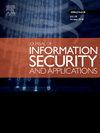研究基于重构攻击的降维方法中的隐私泄露
IF 3.7
2区 计算机科学
Q2 COMPUTER SCIENCE, INFORMATION SYSTEMS
Journal of Information Security and Applications
Pub Date : 2025-05-31
DOI:10.1016/j.jisa.2025.104102
引用次数: 0
摘要
本研究通过一种新颖的基于机器学习的重构攻击来研究降维方法中的隐私泄露。采用知情对手威胁模型,我们开发了一个能够从低维嵌入重建高维数据的神经网络。我们评估了六种流行的降维技术:主成分分析(PCA)、稀疏随机投影(SRP)、多维尺度(MDS)、Isomap、t分布随机邻居嵌入(t-SNE)和均匀流形逼近和投影(UMAP)。使用MNIST和NIH胸部x线数据集,我们进行定性分析以确定影响重建质量的关键因素。此外,我们评估了加性噪声机制在减轻这些重建攻击方面的有效性。我们在两个数据集上的实验结果表明,攻击对确定性方法(PCA和Isomap)是有效的。但对采用随机初始化(SRP, MDS, t-SNE和UMAP)的方法无效。实验结果还表明,对于PCA和Isomap,我们的重建网络比之前提出的网络产生更高质量的输出。我们还研究了加性噪声机制对防止重构攻击的作用。我们的实验表明,在执行PCA或Isomap之前添加具有较大噪声的图像时,攻击会产生严重失真的重建。相比之下,对于其他四种方法,重建仍然显示出一些可识别的特征,尽管它们与原始图像几乎没有相似之处。本文章由计算机程序翻译,如有差异,请以英文原文为准。
Investigating privacy leakage in dimensionality reduction methods via reconstruction attack
This study investigates privacy leakage in dimensionality reduction methods through a novel machine learning-based reconstruction attack. Employing an informed adversary threat model, we develop a neural network capable of reconstructing high-dimensional data from low-dimensional embeddings.
We evaluate six popular dimensionality reduction techniques: principal component analysis (PCA), sparse random projection (SRP), multidimensional scaling (MDS), Isomap, t-distributed stochastic neighbor embedding (), and uniform manifold approximation and projection (UMAP). Using both MNIST and NIH Chest X-ray datasets, we perform a qualitative analysis to identify key factors affecting reconstruction quality. Furthermore, we assess the effectiveness of an additive noise mechanism in mitigating these reconstruction attacks. Our experimental results on both datasets reveal that the attack is effective against deterministic methods (PCA and Isomap). but ineffective against methods that employ random initialization (SRP, MDS, and UMAP). The experimental results also show that, for PCA and Isomap, our reconstruction network produces higher quality outputs compared to a previously proposed network.
We also study the effect of additive noise mechanism to prevent the reconstruction attack. Our experiment shows that, when adding the images with large noises before performing PCA or Isomap, the attack produced severely distorted reconstructions. In contrast, for the other four methods, the reconstructions still show some recognizable features, though they bear little resemblance to the original images.
求助全文
通过发布文献求助,成功后即可免费获取论文全文。
去求助
来源期刊

Journal of Information Security and Applications
Computer Science-Computer Networks and Communications
CiteScore
10.90
自引率
5.40%
发文量
206
审稿时长
56 days
期刊介绍:
Journal of Information Security and Applications (JISA) focuses on the original research and practice-driven applications with relevance to information security and applications. JISA provides a common linkage between a vibrant scientific and research community and industry professionals by offering a clear view on modern problems and challenges in information security, as well as identifying promising scientific and "best-practice" solutions. JISA issues offer a balance between original research work and innovative industrial approaches by internationally renowned information security experts and researchers.
 求助内容:
求助内容: 应助结果提醒方式:
应助结果提醒方式:


